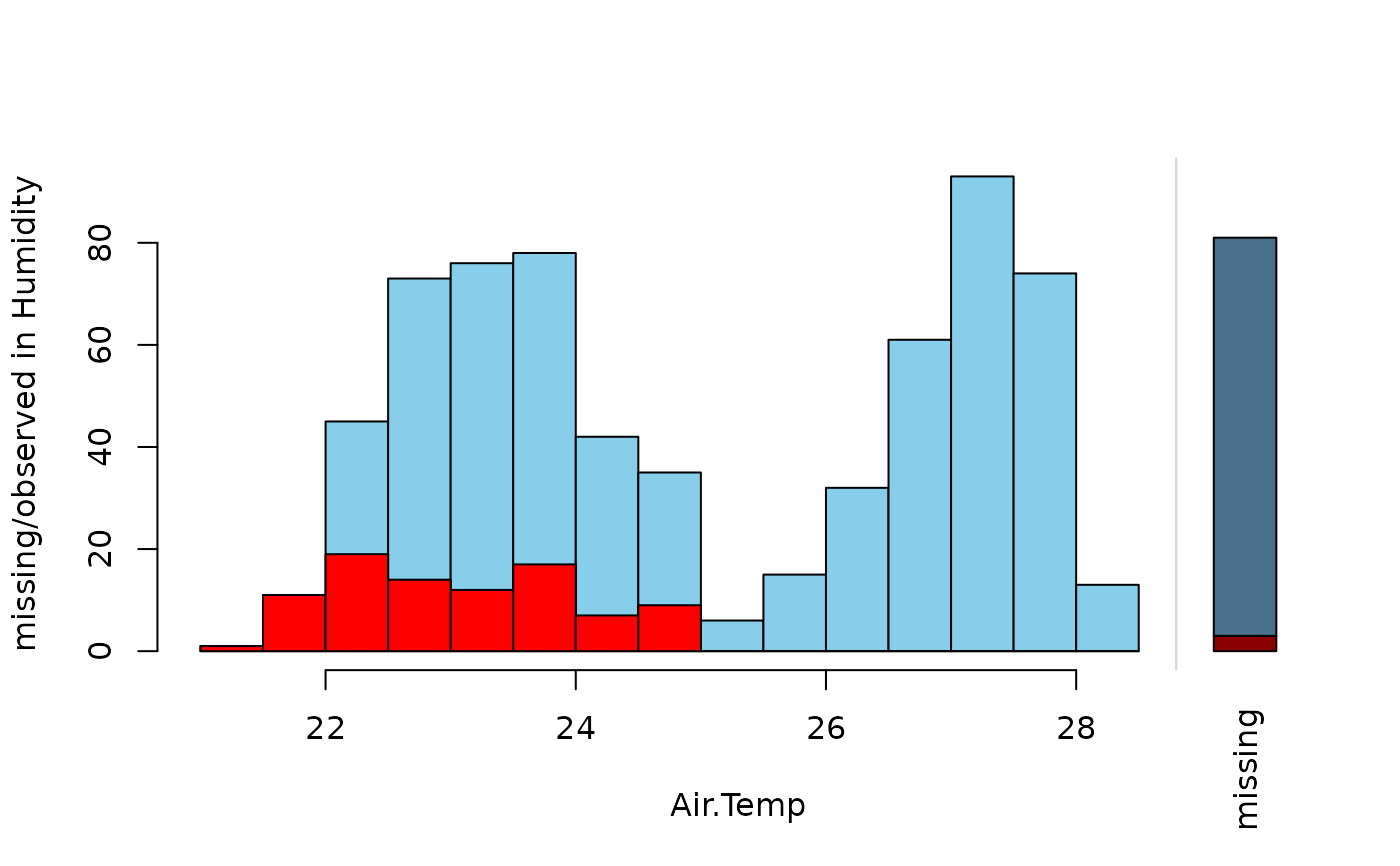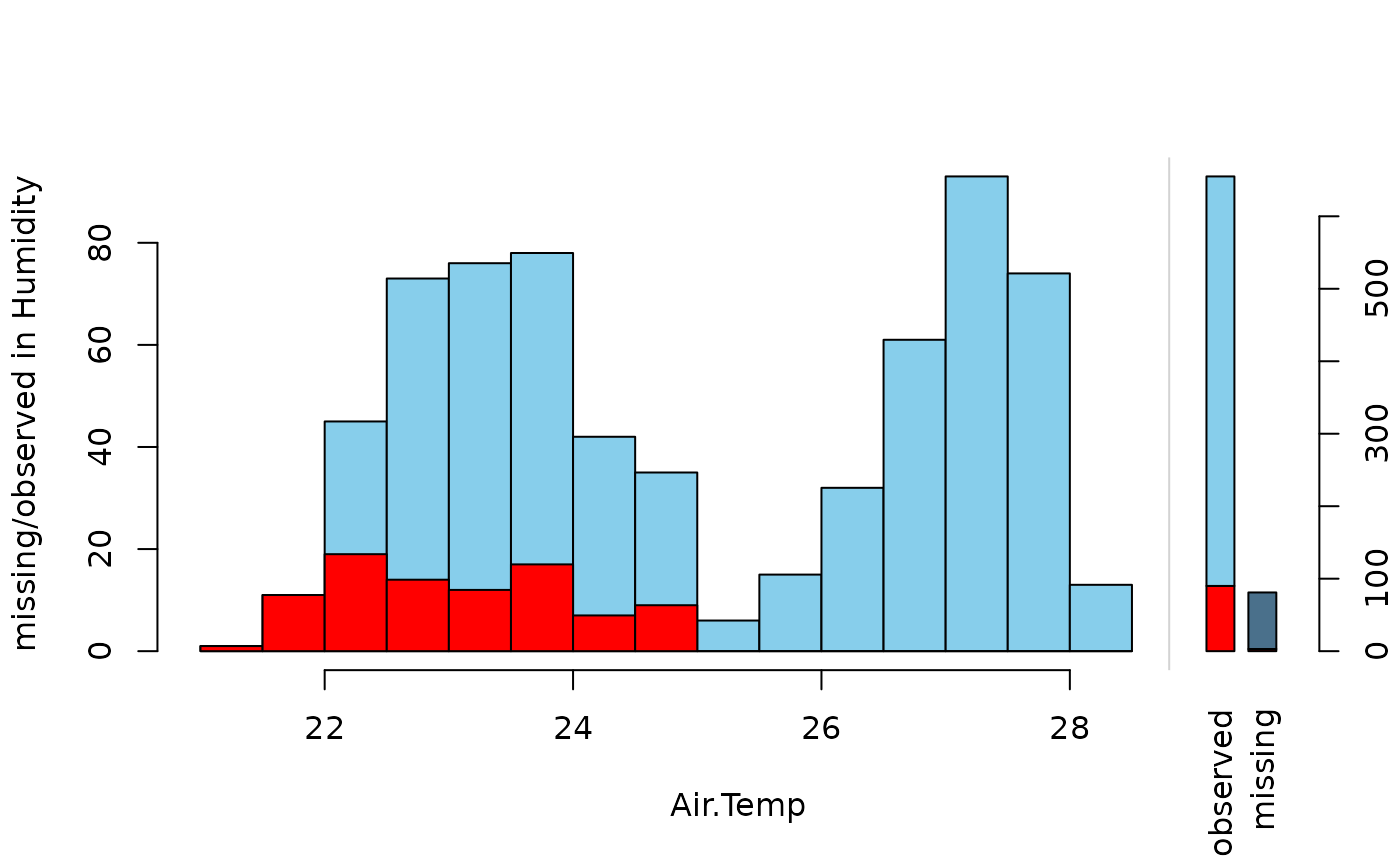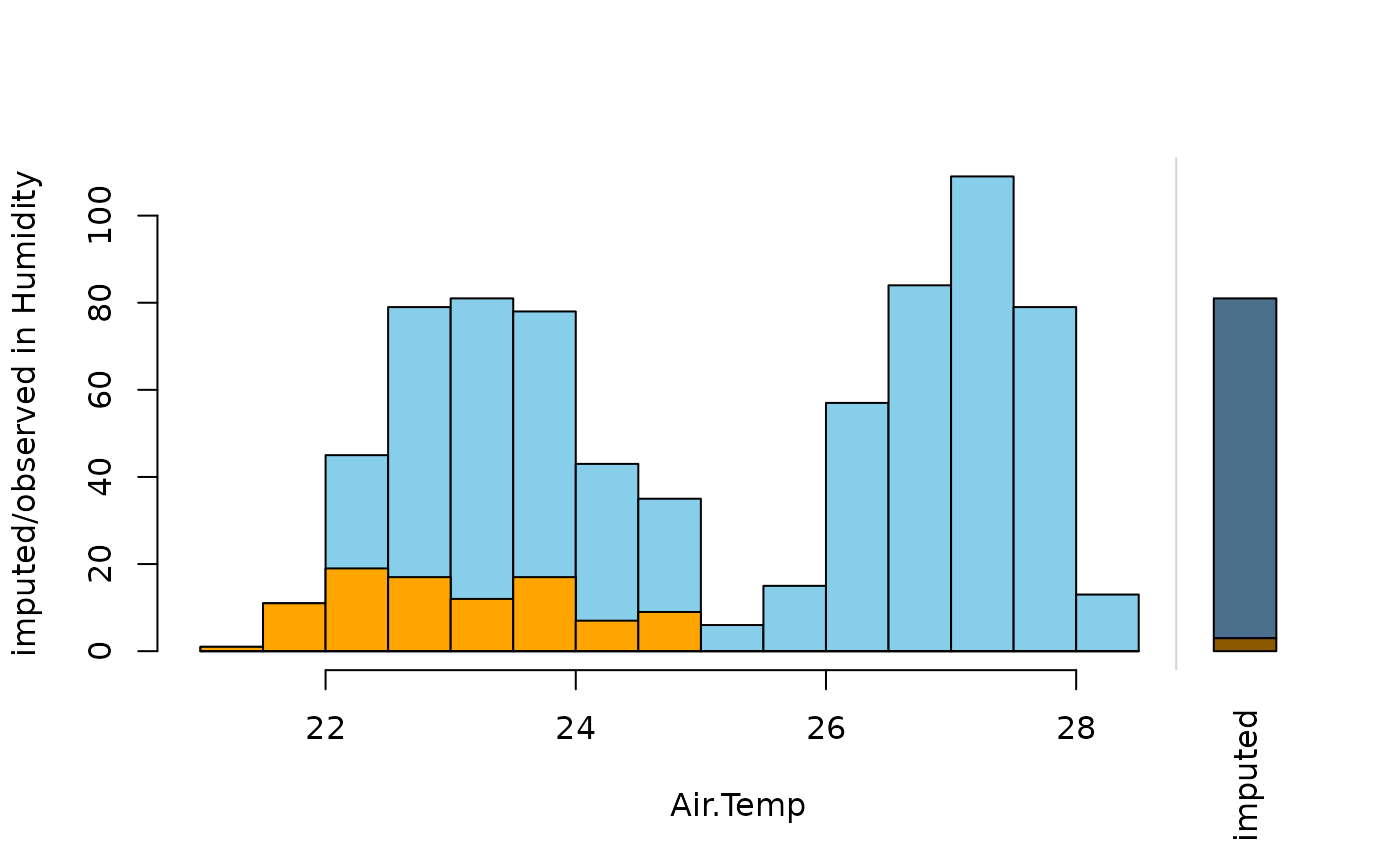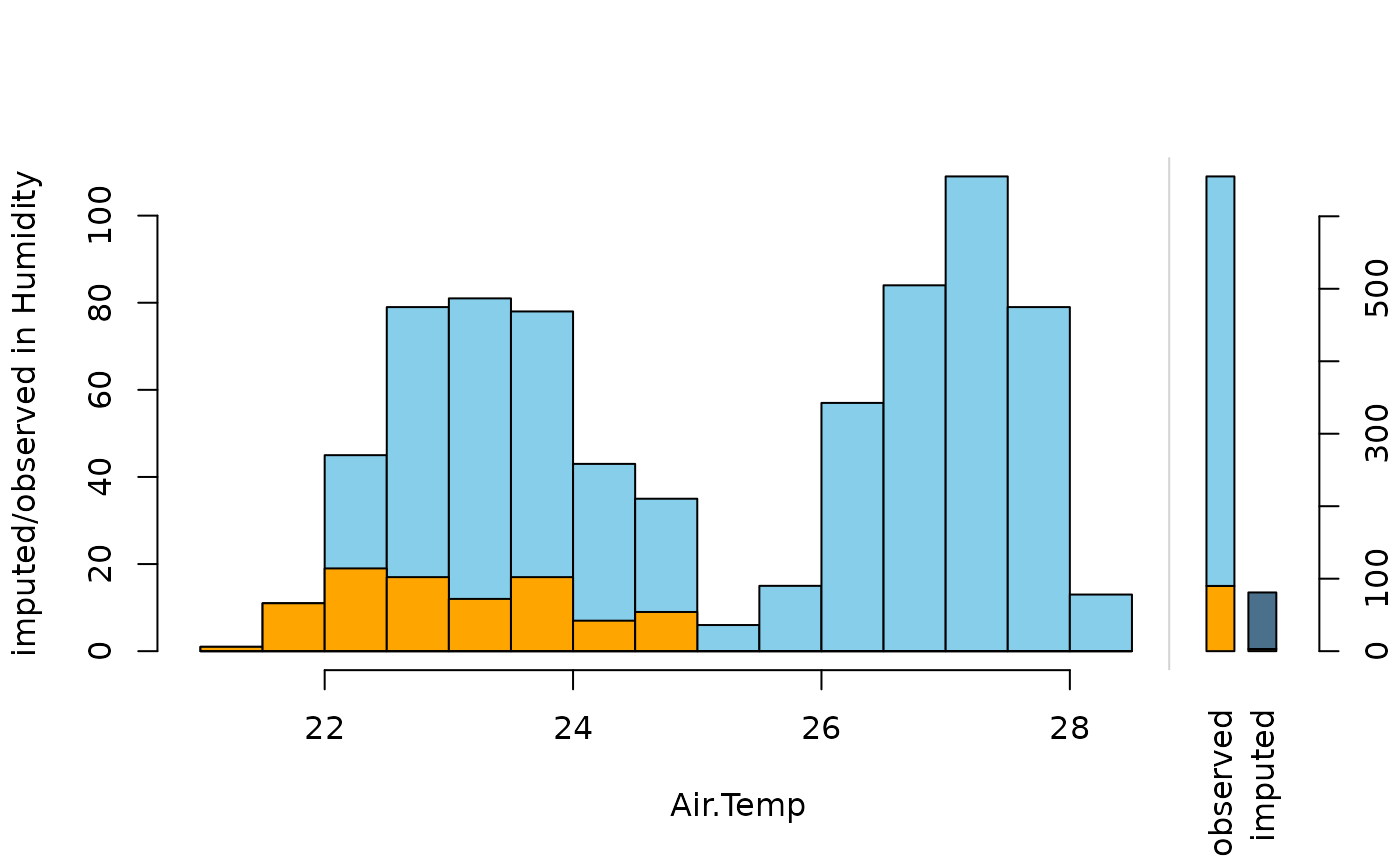Histogram with highlighting of missing/imputed values in other variables by splitting each bin into two parts. Additionally, information about missing/imputed values in the variable of interest is shown on the right hand side.
histMiss(
x,
delimiter = NULL,
pos = 1,
selection = c("any", "all"),
breaks = "Sturges",
right = TRUE,
col = c("skyblue", "red", "skyblue4", "red4", "orange", "orange4"),
border = NULL,
main = NULL,
sub = NULL,
xlab = NULL,
ylab = NULL,
axes = TRUE,
only.miss = TRUE,
miss.labels = axes,
interactive = TRUE,
...
)Arguments
- x
a vector, matrix or
data.frame.- delimiter
a character-vector to distinguish between variables and imputation-indices for imputed variables (therefore,
xneeds to havecolnames()). If given, it is used to determine the corresponding imputation-index for any imputed variable (a logical-vector indicating which values of the variable have been imputed). If such imputation-indices are found, they are used for highlighting and the colors are adjusted according to the given colors for imputed variables (seecol).- pos
a numeric value giving the index of the variable of interest. Additional variables in
xare used for highlighting.- selection
the selection method for highlighting missing/imputed values in multiple additional variables. Possible values are
"any"(highlighting of missing/imputed values in any of the additional variables) and"all"(highlighting of missing/imputed values in all of the additional variables).- breaks
either a character string naming an algorithm to compute the breakpoints (see
hist()), or a numeric value giving the number of cells.- right
logical; if
TRUE, the histogram cells are right-closed (left-open) intervals.- col
a vector of length six giving the colors to be used. If only one color is supplied, the bars are transparent and the supplied color is used for highlighting missing/imputed values. Else if two colors are supplied, they are recycled.
- border
the color to be used for the border of the cells. Use
border=NAto omit borders.- main, sub
main and sub title.
- xlab, ylab
axis labels.
- axes
a logical indicating whether axes should be drawn on the plot.
- only.miss
logical; if
TRUE, the missing/imputed values in the first variable are visualized by a single bar. Otherwise, a small barplot is drawn on the right hand side (see ‘Details’).- miss.labels
either a logical indicating whether label(s) should be plotted below the bar(s) on the right hand side, or a character string or vector giving the label(s) (see ‘Details’).
- interactive
a logical indicating whether the variables can be switched interactively (see ‘Details’).
- ...
further graphical parameters to be passed to
graphics::title()andgraphics::axis().
Value
a list with the following components:
breaks the breakpoints.
counts the number of observations in each cell.
missings the number of highlighted observations in each cell.
mids the cell midpoints.
Details
If more than one variable is supplied, the bins for the variable of interest will be split according to missingness/number of imputed missings in the additional variables.
If only.miss=TRUE, the missing/imputed values in the variable of
interest are visualized by one bar on the right hand side. If additional
variables are supplied, this bar is again split into two parts according to
missingness/number of imputed missings in the additional variables.
Otherwise, a small barplot consisting of two bars is drawn on the right hand
side. The first bar corresponds to observed values in the variable of
interest and the second bar to missing/imputed values. Since these two bars
are not on the same scale as the main barplot, a second y-axis is plotted on
the right (if axes=TRUE). Each of the two bars are again split into
two parts according to missingness/number of imputed missings in the
additional variables. Note that this display does not make sense if only
one variable is supplied, therefore only.miss is ignored in that
case.
If interactive=TRUE, clicking in the left margin of the plot results
in switching to the previous variable and clicking in the right margin
results in switching to the next variable. Clicking anywhere else on the
graphics device quits the interactive session. When switching to a
categorical variable, a barplot is produced rather than a histogram.
Note
Some of the argument names and positions have changed with version 1.3
due to extended functionality and for more consistency with other plot
functions in VIM. For back compatibility, the arguments
axisnames and names.miss can still be supplied to
...{} and are handled correctly. Nevertheless, they are deprecated
and no longer documented. Use miss.labels instead.
References
M. Templ, A. Alfons, P. Filzmoser (2012) Exploring incomplete data using visualization tools. Journal of Advances in Data Analysis and Classification, Online first. DOI: 10.1007/s11634-011-0102-y.
See also
Other plotting functions:
aggr(),
barMiss(),
marginmatrix(),
marginplot(),
matrixplot(),
mosaicMiss(),
pairsVIM(),
parcoordMiss(),
pbox(),
scattJitt(),
scattMiss(),
scattmatrixMiss(),
spineMiss()
Examples
data(tao, package = "VIM")
## for missing values
x <- tao[, c("Air.Temp", "Humidity")]
histMiss(x)
 histMiss(x, only.miss = FALSE)
histMiss(x, only.miss = FALSE)
 ## for imputed values
x_IMPUTED <- kNN(tao[, c("Air.Temp", "Humidity")])
histMiss(x_IMPUTED, delimiter = "_imp")
## for imputed values
x_IMPUTED <- kNN(tao[, c("Air.Temp", "Humidity")])
histMiss(x_IMPUTED, delimiter = "_imp")
 histMiss(x_IMPUTED, delimiter = "_imp", only.miss = FALSE)
histMiss(x_IMPUTED, delimiter = "_imp", only.miss = FALSE)
